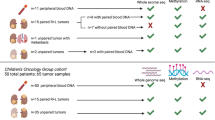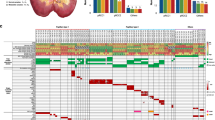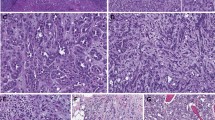Abstract
To investigate the role of tumour-suppressor genes on the short arm of chromosome 3 in the mechanism of tumorigenesis in non-familial renal cell carcinoma, we analysed 55 paired blood-tumour DNA samples for allele loss on chromosome 3p and in the region of known or putative tumour-suppressor genes on chromosomes 5, 11, 17 and 22. Sixty-four per cent (35/55) of informative tumours showed loss of heterozygosity (LOH) of at least one locus on the short arm of chromosome 3, compared with only 13% at the p53 tumour-suppressor gene and 6% at 17q21. LOH at chromosome 5q21 and 22q was uncommon (2-3%). Detailed analysis of the regions of LOH on chromosome 3p suggested that, in addition to the VHL gene in chromosome 3p25-p26, mutations in one or more tumour-suppressor genes in chromosome 3p13-p24 may be involved in the pathogenesis of sporadic renal cell carcinoma (RCC). We also confirmed previous suggestions that chromosome 3p allele loss is not a feature of papillary RCC (P < 0.05).
This is a preview of subscription content, access via your institution
Access options
Subscribe to this journal
Receive 24 print issues and online access
$259.00 per year
only $10.79 per issue
Buy this article
- Purchase on Springer Link
- Instant access to full article PDF
Prices may be subject to local taxes which are calculated during checkout
Similar content being viewed by others
Author information
Authors and Affiliations
Rights and permissions
About this article
Cite this article
Foster, K., Crossey, P., Cairns, P. et al. Molecular genetic investigation of sporadic renal cell carcinoma: analysis of allele loss on chromosomes 3p, 5q, 11p, 17 and 22. Br J Cancer 69, 230–234 (1994). https://doi.org/10.1038/bjc.1994.44
Issue Date:
DOI: https://doi.org/10.1038/bjc.1994.44
This article is cited by
-
Chromosome 17p13 deletion is associated with an aggressive tumor phenotype in clear cell renal cell carcinoma
World Journal of Surgical Oncology (2020)
-
DNA Methylation and Flavonoids in Genitourinary Cancers
Current Pharmacology Reports (2015)
-
Recurrent chromosomal gains and heterogeneous driver mutations characterise papillary renal cancer evolution
Nature Communications (2015)
-
VHL and HIF-1α: gene variations and prognosis in early-stage clear cell renal cell carcinoma
Medical Oncology (2014)
-
CpG methylation profiling in VHL related and VHL unrelated renal cell carcinoma
Molecular Cancer (2009)



